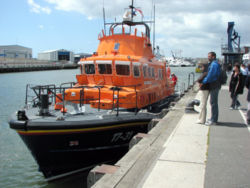
Bow (ship)
Encyclopedia

Hull (watercraft)
A hull is the watertight body of a ship or boat. Above the hull is the superstructure and/or deckhouse, where present. The line where the hull meets the water surface is called the waterline.The structure of the hull varies depending on the vessel type...
of a ship
Ship
Since the end of the age of sail a ship has been any large buoyant marine vessel. Ships are generally distinguished from boats based on size and cargo or passenger capacity. Ships are used on lakes, seas, and rivers for a variety of activities, such as the transport of people or goods, fishing,...
or boat
Boat
A boat is a watercraft of any size designed to float or plane, to provide passage across water. Usually this water will be inland or in protected coastal areas. However, boats such as the whaleboat were designed to be operated from a ship in an offshore environment. In naval terms, a boat is a...
, the point that is most forward when the vessel is underway. Both of the adjectives fore and forward mean towards the bow. The other end of the boat is called the stern
Stern
The stern is the rear or aft-most part of a ship or boat, technically defined as the area built up over the sternpost, extending upwards from the counter rail to the taffrail. The stern lies opposite of the bow, the foremost part of a ship. Originally, the term only referred to the aft port section...
.
Function

Drag (physics)
In fluid dynamics, drag refers to forces which act on a solid object in the direction of the relative fluid flow velocity...
of the hull cutting through water and should be tall enough to prevent water from easily washing over the top of it. On slower ships like tankers, a fuller bow shape is used to maximise the volume of the ship for a given length.
A "wet bow" results from seawater washing over the top of the hull. A raked stem can help to reduce the wetness of the bow. Aside from making the deck slippery, water can corrode the metal of the ship. If the temperature is low enough this water can also freeze on the deck, rails, turrets, and other exposed surfaces, increasing the topside weight.
Parts
The forward part of the bow, usually on the ship's centreline, is called the stem. Traditionally, the stem was an upright timber or metal bar into which side planks or plates were joined.Types
Several types of bows exist. These include :- TumblehomeTumblehomeIn ship designing, the tumblehome is the narrowing of a ship's hull with greater distance above the water-line. Expressed more technically, it is present when the beam at the uppermost deck is less than the maximum beam of the vessel....
- Raised foredeck
- Reverse sheer
- Conventional clipper
- Low-cain spoon bow
- High-cain spoon bow
- X-BowX-bow (shipbuilding)The Ulstein X-bow is an inverted ship's bow designed by Ulstein Group to improve handling in rough sea, and to lower fuel consumption by causing less hydrodynamic drag...
(Developed by the Ulstein Group) - Ram bow
- Bulbous bowBulbous bowA bulbous bow is a protruding bulb at the bow of a ship just below the waterline. The bulb modifies the way the water flows around the hull, reducing drag and thus increasing speed, range, fuel efficiency, and stability...
See also
- Boat buildingBoat buildingBoat building, one of the oldest branches of engineering, is concerned with constructing the hulls of boats and, for sailboats, the masts, spars and rigging.-Parts:* Bow - the front and generally sharp end of the hull...
- Bow (rowing)Bow (rowing)Bow is a term which has multiple meanings within the sport of rowing. It is used to refer to a rower seated in a particular position and to one side of the boat.-Bow:...
- DeckDeck (ship)A deck is a permanent covering over a compartment or a hull of a ship. On a boat or ship, the primary deck is the horizontal structure which forms the 'roof' for the hull, which both strengthens the hull and serves as the primary working surface...
- Figurehead
- Naval architectureNaval architectureNaval architecture is an engineering discipline dealing with the design, construction, maintenance and operation of marine vessels and structures. Naval architecture involves basic and applied research, design, development, design evaluation and calculations during all stages of the life of a...
- Port
- ProwProwthumb|right|295pxThe prow is the forward most part of a ship's bow that cuts through the water. The prow is the part of the bow above the waterline. The terms prow and bow are often used interchangeably to describe the most forward part of a ship and its surrounding parts...
- ShipbuildingShipbuildingShipbuilding is the construction of ships and floating vessels. It normally takes place in a specialized facility known as a shipyard. Shipbuilders, also called shipwrights, follow a specialized occupation that traces its roots to before recorded history.Shipbuilding and ship repairs, both...
- Starboard
- Stem (ship)Stem (ship)The stem is the very most forward part of a boat or ship's bow and is an extension of the keel itself and curves up to the wale of the boat. The stem is more often found on wooden boats or ships, but not exclusively...
- SuperstructureSuperstructureA superstructure is an upward extension of an existing structure above a baseline. This term is applied to various kinds of physical structures such as buildings, bridges, or ships...
Further reading
- Sleight, Steve; The New Complete Sailing Manual, Dorling Kindersley Co., (2005) ISBN 0-7566-0944-5
- Steward, Robert; Boatbuilding Manual, 3rd ed. International Marine Publishing Company. Camden, Maine (1987), p2-3. ISBN 0-87742-236-2

